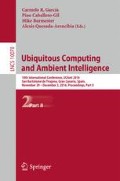Abstract
There is an increasing need for personalised and context-aware services in our everyday lives and we rely on mobile and wearable devices to provide such services. Context-aware applications often make use of machine-learning algorithms, but many of these are too complex or resource-consuming for implementation on some devices that are common in pervasive and mobile computing. The algorithm presented in this paper, named CAMP, has been developed to obtain a classifier that is suitable for resource-constrained devices such as FPGA:s, ASIC:s or microcontrollers. The algorithm uses a combination of the McCulloch-Pitts neuron model and Cellular Automata in order to produce a computationally inexpensive classifier with a small memory footprint. The algorithm consists of a sparse binary neural network where neurons are updated using a Cellular Automata rule as the activation function. Output of the classifier is depending on the selected rule and the interconnections between the neurons. Since solving the input-output mapping mathematically can not be performed using traditional optimization algorithms, the classifier is trained using a genetic algorithm. The results of the study show that CAMP, despite its minimalistic structure, has a comparable accuracy to that of more advanced algorithms for the datasets tested containing few classes, while performing poorly on the datasets with a higher amount of classes. CAMP could thus be a viable choice for solving classification problems in environments with extreme demands on low resource consumption.
Access this chapter
Tax calculation will be finalised at checkout
Purchases are for personal use only
References
Adachi, M., Aihara, K.: Associative dynamics in a chaotic neural network. Neural Netw. 10(1), 83–98 (1997)
Aihara, K., Matsumoto, G.: Forced oscillations and routes to chaos in the Hodgkin-Huxley axons and squid giant axons. In: Degn, H., Holden, A.V., Olsen, L.F. (eds.) Chaos in Biological Systems, pp. 121–131. Springer, New York (1987)
Aihara, K., Matsumoto, G.: Chaotic oscillations and bifurcations in squid giant axons. Chaos 12, 257–269 (1986)
Basar, E.: Chaos in Brain Function: Containing Original Chapters by E. Basar and T.H. Bullock and Topical Articles Reprinted from the Springer Series in Brain Dynamics. Springer Science & Business Media, Heidelberg (2012)
Batrk, A., Gnay, E.: Efficient edge detection in digital images using a cellular neural network optimized by differential evolution algorithm. Expert Syst. Appl. 36(2), 2645–2650 (2009). http://linkinghub.elsevier.com/retrieve/pii/S0957417408000420
Bitner, J.R., Ehrlich, G., Reingold, E.M.: Efficient generation of the binary reflected gray code and its applications. Commun. ACM 19(9), 517–521 (1976). http://portal.acm.org/citation.cfm?doid=360336.360343
Bolon-Canedo, V., Sanchez-Marono, N., Alonso-Betanzos, A.: A review of feature selection methods on synthetic data. Knowl. Inf. Syst. 34(3), 483–519 (2013)
Chattopadhyay, S., Adhikari, S., Sengupta, S., Pal, M.: Highly regular, modular, and cascadable design of cellular automata-based pattern classifier. IEEE Trans. Very Large Scale Integr. (VLSI) Syst. 8(6), 724–735 (2000)
Chaudhuri, P.P.: Additive Cellular Automata: Theory and Applications, vol. 1. Wiley, California (1997)
Cook, M.: Universality in elementary cellular automata. Complex Syst. 15(1), 1–40 (2004)
Cotton, N.J., Wilamowski, B.M., Dundar, G.: A neural network implementation on an inexpensive eight bit microcontroller, pp. 109–114. IEEE, February 2008. http://ieeexplore.ieee.org/lpdocs/epic03/wrapper.htm?arnumber=4481278
Crook, P., Marsland, S., Hayes, G., Nehmzow, U., et al.: A tale of two filters-on-line novelty detection. In: Proceedings of the IEEE International Conference on Robotics and Automation, ICRA 2002, vol. 4, pp. 3894–3899. IEEE (2002)
Duke, D.W., Pritchard, W.S.: Proceedings of the Conference on Measuring Chaos in the Human Brain, 3–5 April 1991, at the Supercomputer Computations Research Institute, Florida State University, Tallahassee, FL. World Scientific (1991)
Ercsey-Ravasz, M., Roska, T., Nda, Z.: Statistical physics on cellular neural network computers. Phys. D Nonlinear Phenom. 237(9), 1226–1234 (2008). http://linkinghub.elsevier.com/retrieve/pii/S016727890800122X
Ganguly, N., Maji, P., Sikdar, B., Chaudhuri, P.: Design and characterization of cellular automata based associative memory for pattern recognition. IEEE Trans. Syst. Man Cybern. Part B (Cybern.) 34(1), 672–678 (2004). http://ieeexplore.ieee.org/lpdocs/epic03/wrapper.htm?arnumber=1262538
Hunt, K.J.: Neural networks for control systems - a survey. Automatica 28, 1083–1112 (1992)
Kocsrdi, S., Nagy, Z., Csk, Á., Szolgay, P.: Simulation of 2d inviscid, adiabatic, compressible flows on emulated digital cnn-um. Int. J. Circ. Theory Appl. 37(4), 569–585 (2009). http://doi.wiley.com/10.1002/cta.565
Maji, P., Ganguly, N., Saha, S., Roy, A.K., Chaudhuri, P.P.: Cellular automata machine for pattern recognition. In: Bandini, S., Chopard, B., Tomassini, M. (eds.) ACRI 2002. LNCS, vol. 2493, pp. 270–281. Springer, Heidelberg (2002). doi:10.1007/3-540-45830-1_26
Sarkar, P.: A brief history of cellular automata. ACM Comput. Surv. 32(1), 80–107 (2000). http://portal.acm.org/citation.cfm?doid=349194.349202
Schaffer, J.D., Whitley, D., Eshelman, L.J.: Combinations of genetic algorithms and neural networks: a survey of the state of the art. In: International Workshop on Combinations of Genetic Algorithms and Neural Networks, COGANN-1992, pp. 1–37. IEEE (1992)
Schmitt, M.: On the size of weights for mcculloch-pitts neurons. In: Proceedings of the Sixth Italian Workshop on Neural Nets WIRN VIETRI-1993, pp. 241–246. Citeseer (1994)
Smith, D., Stanford, P.: A random walk in hamming space, vol. 2, pp. 465–470. IEEE (1990). http://ieeexplore.ieee.org/lpdocs/epic03/wrapper.htm?arnumber=5726715
Vellido, A., Lisboa, P.J.G., Vaughan, J.: Neural networks in business: a survey of applications (1992–1998). Expert Syst. Appl. 17, 51–70 (1999)
Weston, J., Watkins, C.: Multi-class support vector machines. Technical report. Citeseer (1998)
Witten, I.H., Frank, E.: Data Mining: Practical Machine Learning Tools and Techniques. Morgan Kaufmann, San Francisco (2005)
Wolfram, S.: A New Kind of Science, vol. 5. Wolfram Media, Champaign (2002)
Zhen-zhen, X., Su-yu, Z.: A non-linear approximation of the sigmoid function based FPGA. In: Jiang, L. (ed.) ICCE 2011. AISC, vol. 111, pp. 125–132. Springer, Heidelberg (2012)
Author information
Authors and Affiliations
Corresponding author
Editor information
Editors and Affiliations
Rights and permissions
Copyright information
© 2016 Springer International Publishing AG
About this paper
Cite this paper
Karvonen, N., Kikhia, B., Jiménez, L.L., Gómez Simón, M., Hallberg, J. (2016). A Computationally Inexpensive Classifier Merging Cellular Automata and MCP-Neurons. In: García, C., Caballero-Gil, P., Burmester, M., Quesada-Arencibia, A. (eds) Ubiquitous Computing and Ambient Intelligence. IWAAL AmIHEALTH UCAmI 2016 2016 2016. Lecture Notes in Computer Science(), vol 10070. Springer, Cham. https://doi.org/10.1007/978-3-319-48799-1_42
Download citation
DOI: https://doi.org/10.1007/978-3-319-48799-1_42
Published:
Publisher Name: Springer, Cham
Print ISBN: 978-3-319-48798-4
Online ISBN: 978-3-319-48799-1
eBook Packages: Computer ScienceComputer Science (R0)

